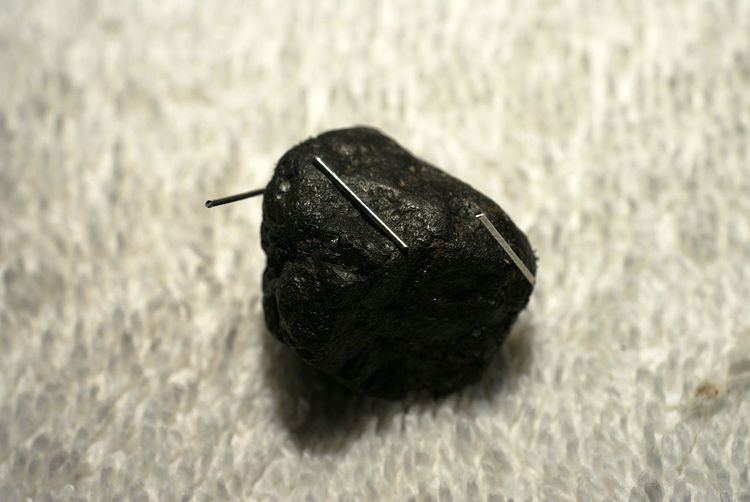 | ||
A lodestone is a naturally magnetized piece of the mineral magnetite. They are naturally occurring magnets, which can attract iron. The property of magnetism was first discovered in antiquity through lodestones. Pieces of lodestone, suspended so they could turn, were the first magnetic compasses, and their importance to early navigation is indicated by the name lodestone, which in Middle English means 'course stone' or 'leading stone', from the now-obsolete meaning of lode as ‘journey, way’.
Contents
Lodestone is one of the few minerals that is found naturally magnetized. Magnetite is black or brownish-black, with a metallic luster, a Mohs hardness of 5.5–6.5 and a black streak.
Origin
The process by which lodestone is created has long been an open question in geology. Only a small amount of the magnetite on Earth is found magnetized as lodestone. Ordinary magnetite is attracted to a magnetic field like iron and steel is, but does not tend to become magnetized itself; it has too low a magnetic coercivity (resistance to demagnetization) to stay magnetized for long. Microscopic examination of lodestones has found them to be made of magnetite (Fe3O4) with inclusions of maghemite (cubic Fe2O3), often with impurity metal ions of titanium, aluminium, and manganese. This inhomogeneous crystalline structure gives this variety of magnetite sufficient coercivity to remain magnetized and thus be a permanent magnet.
The other question is how lodestones get magnetized. The Earth's magnetic field at 0.5 gauss is too weak to magnetize a lodestone by itself. The leading theory is that lodestones are magnetized by the strong magnetic fields surrounding lightning bolts. This is supported by the observation that they are mostly found near the surface of the Earth, rather than buried at great depth.
History
One of the first references to lodestone's magnetic properties was made by 6th century BC Greek philosopher Thales of Miletus, whom the ancient Greeks credited with discovering lodestone's attraction to iron and other lodestones. The name magnet may come from lodestones found in Magnesia, Anatolia.
The earliest Chinese literary reference to magnetism occurs in a 4th-century BC Book of the Devil Valley Master (Guiguzi). In the chronicle Lüshi Chunqiu, from the 2nd century BC, it is explicitly stated that "the lodestone makes iron come or it attracts it." The earliest mention of a needle's attraction appears in a work composed between 20 and 100 AD, the Lunheng (Balanced Inquiries): "A lodestone attracts a needle." Medieval Chinese navigators were using lodestone compasses by the 12th century.
Based on his discovery of an Olmec artifact (a shaped and grooved magnetic bar) in Central America, astronomer John Carlson suggests that lodestone may have been used by the Olmec more than a thousand years prior to the Chinese discovery. Carlson speculates that the Olmecs, for astrological or geomantic purposes, used similar artifacts as a directional device, or to orient their temples, the dwellings of the living, or the interments of the dead. Detailed analysis of the Olmec artifact revealed that the "bar" was composed of hematite with titanium lamellae of Fe2–xTixO3 that accounted for the anomalous remanent magnetism of the artifact.
